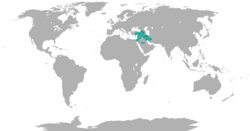| Armenian gull | |
|---|---|
 | |
| Scientific classification | |
| Kingdom: | Animalia |
| Phylum: | Chordata |
| Class: | Aves |
| Order: | Charadriiformes |
| Family: | Laridae |
| Genus: | Larus |
| Species: | L. armenicus |
| Binomial name | |
| Larus armenicus Buturlin, 1934 | |
 | |
| Synonyms [2] | |
Larus cachinnans armenicus | |
The Armenian gull (Larus armenicus) is a large gull found in the Caucasus and the Middle East. It was formerly classified as a subspecies of the European herring gull (L. argentatus), but is now generally considered to be a separate species, although BirdLife International lumps it with the yellow-legged gull (L. michahellis).





